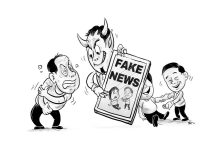
[av_one_full first min_height=” vertical_alignment=” space=” custom_margin=” margin=’0px’ padding=’0px’ border=” border_color=” radius=’0px’ background_color=” src=” background_position=’top left’ background_repeat=’no-repeat’ animation=”]
[av_heading heading=’INTERNATIONAL ILONGGO | An obsolete model’ tag=’h3′ style=’blockquote modern-quote’ size=” subheading_active=’subheading_below’ subheading_size=’15’ padding=’10’ color=” custom_font=”]
BY JED JALECO DEL ROSARIO
[/av_heading]
[av_textblock size=” font_color=” color=”]
Sunday, June 25, 2017
[/av_textblock]
[av_textblock size=” font_color=” color=”]
LAST WEEK I wrote about non-state actors. This week, I want to expand on that subject by talking a bit about the state itself.
When academics discuss the “state,” what they are actually referring to is the Westphalian Nation-State model, and its key characteristic: “The monopoly of the legitimate use of physical force or violence.” The state is the framework which gives the nation its form and coherence. It is the system which sets apart the modern nation from a pre-modern society held together by familial or feudal ties.
As important as the state may be, however, it’s important to remember that a nation can exist without it. A good example are the Kurds, who despite being a distinct people, live as minorities in various states in the Middle East. Another good example are the Koreans. Although North and South Koreans belong to the same nation/ethnic group, they have two distinct states due to their unique historical circumstances.
Thus, it is important not to conflate the state with the nation. It’s also important to remember that the a state cannot long exist without a stable, relatively homogenous nation. Thus the modern nation-state is ultimately a political tool masquerading as a political entity, and like all tools, it has its expiry date.
Today, the nation-state model is on its way to becoming obsolete due to globalization. Globalization – as I’ve written before – aims to eliminate barriers to trade and immigration, which is anathema to the nation-state.
Filipinos may not consider this a big deal, but consider our own agreements with ASEAN. Multilateral interdependence has been the trend in recent years, and is now being replaced by a creeping decentralization thanks to the internet and technologies that undermine consumer capitalism.
In contrast, the nation-state model was developed to centralize a particular nation or ethnic group. To some extent, the nation-state is also the foundation of modern mass society, and the consumer-capitalist economics. It was not intended to promote globalization, nor was it designed to cope with the technological and social changes of the 21st century. Thus, my thesis is that the nation-state model cannot adapt to the challenges that we face today.
Now, what does any of this mean for the common Filipino? It means that the society we now take for granted may be fading away. It also means that the problems faced by more globalized and developed countries may come to our shores in the coming years. After all, in a globalized world, nations don’t live in vacuums, and what happens to developed countries will happen to the developing ones sooner or later.
However, as troubling as this may seem, it’s important to remember that our nation will survive even if the state becomes obsolete. It’s just a matter of adapting to the future’s challenges./PN
[/av_textblock]
[/av_one_full]







